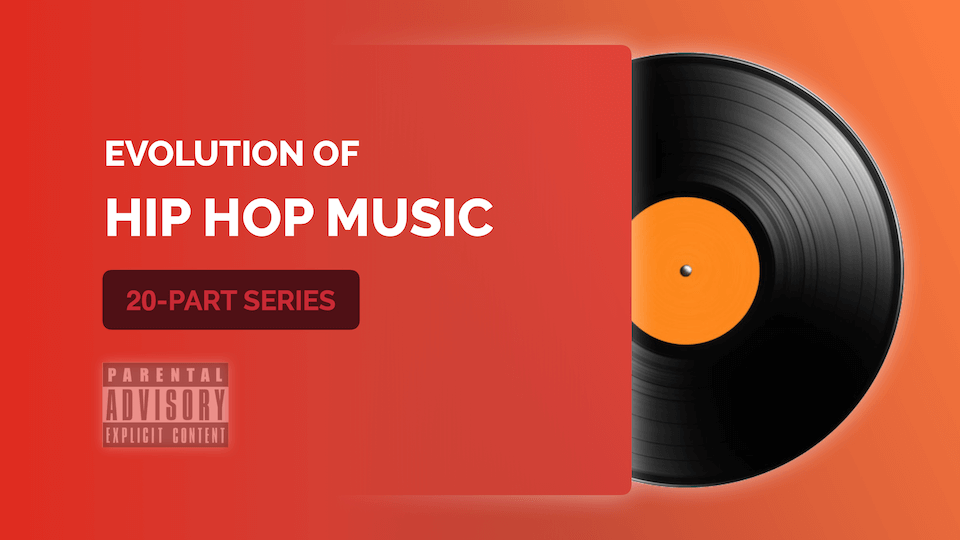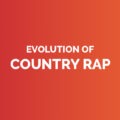As we approach rap’s 50th anniversary, Evolution of Hip Hop chronicles the history of the genre’s early days in New York City to its present day domination of the pop charts.
In 2018, hip hop replaced rock music as the best-selling genre of music in America, marking an incredible rise in popularity that all started at a Bronx birthday party in 1973. It was on that day that DJ Cool Herc used two identical records to create extended drum breakdowns, and hyped up the crowd by hollering over top. From vocals inspired by street poets and bombastic wordsmiths like Muhammad Ali to the upbeat musical elements of R&B and funk, the birth of hip hop wasn’t just a conversion of styles, but one of the most significant moments in the evolution of politics, race and music in America.
Old School Hip Hop
New York, 1973
Old school hip hop wasn’t merely a new style; it was a reflection on a new era for politics, race, and music in America. The lived experiences of 1970s and 80s black artists can be heard in the sonic influences of their tracks. Vocals inspired by Protestant church choirs, upbeat musical elements of R&B, funk, soul, and jazz, and samples from bombastic wordsmiths like Muhammad Ali and Richard Pryor, are just some of the unique features of old school hip hop.
Learn more about the evolution of Old School Hip Hop ▸
Electro
Planet Earth, 1980
Electro (also known as electro funk) was the result of musicians using electronic instruments to recreate the structure and feel of funk music. Upbeat basslines, catchy synth riffs, drum machine beats and a whole lot of record scratching were the trademarks of the genre, where the latest technology met the street rap and boogie of New York’s emerging hip hop scene.
Learn more about the evolution of Electro ▸
Rap Rock
New York, 1984
Adding hip hop vocals to mid-tempo rock was a eureka moment for the music industry. In the same way that Elvis took the blues from the southern juke joints to airwaves across the country, rap rock took hip hop from the urban streets and introduced it to the masses. This combination of styles had a huge influence on the music industry for decades, leading to rap metal, it’s offspring Nu metal, and even some forms of experimental Trap.
Learn more about the evolution of Rap Rock ▸
Gangsta Rap
Los Angeles, 1985
By the mid 80s, rap had reached the mainstream. And while the hip hop sound was very much from the streets, the lyrics of early RUN D.M.C. and L.L. Cool J didn’t resonate with those living in the low-income urban neighbourhoods of New York, LA, Philadelphia and beyond. Gangsta rap was a response to that, with grittier lyrics that spoke of real life in poverty-stricken areas where crime and drugs were an everyday reality.
Learn more about the evolution of Gangsta Rap ▸
Miami Bass
Miami, 1985
In the 80s DJs quickly realized that the thumping beat of house music got people dancing, and the result was numerous variations of this style in cities across the country. One such evolution of house music was Miami bass, where the bass from electro funk records was blasted, and overtly sexual hip hop vocals were delivered with frantic hype man energy.
Learn more about the evolution of Miami Bass ▸
Hardcore Hip Hop
New York, 1987
Gangsta rap and hardcore have a lot in common musically, but hardcore hip hop was a genre that didn’t focus exclusively on exploiting the gang life style, in fact many of the artists were using rap to deliver scathing critiques on everything that they felt was wrong in the world. White supremacy, inequality, politics, police brutality, (as well as gang life) were all explored in what was an extremely creative time in hip hop and is often referred to as the golden age.
Learn more about the evolution of Hardcore Hip Hop ▸
Boom Bap
New York, 1988
Boom bap is a style of hip hop that’s heavily influenced by early samplers and drum machines, with the accent being on the kick and snare (the “boom” and the “bap”). The genre produced a great number of popular artists from a Tribe Called Quest, to Wu-Tang to Notorious B.I.G, and continues to influence artists forty years later.
Learn more about the evolution of Boom Bap ▸
Horrorcore
Houston, 1989
In the early 1980s hip hop artists turned to the horror genre for inspiration and produced radio-friendly tracks like “Nightmare On My Street” by The Fresh Prince, and Dana Dane’s “Nightmares”. These rather innocent songs paved the way for what would become a really violent and disturbing style of lyrical realism in the popular and often controversial horrorcore genre.
Learn more about the evolution of Horrorcore ▸
Alternative Hip Hop
New York, 1989
Alternative hip hop is a collection of styles that grew out of old school rap but whose influences were far broader than those found in hardcore, pop and gangsta (the dominant styles at the time). These artists were creating hip hop using jazz, pop, rock music, funk and soul but with the important addition of lyrics that captured a greater spectrum of topics, from social justice, to politics and even observational humour.
Learn more about the evolution of Alternative Hip Hop ▸
G-Funk
California, 1990
While New York hip hop was producing gangsta rap and hardcore, Los Angeles was developing a mellow sound that was more in line with the laid-back West Coast lifestyle. G-funk took the best elements of James Brown and Parliament (smooth as silk bass lines and funky drums), dressed it up with wavering synths and rapped about street life over top.
Learn more about the evolution of G-Funk ▸
Latin Hip Hop
Puerto Rico, 1990
Latin hip hop evolved alongside American hip hop, infusing South American elements into boom bap, gangsta rap and eventually more modern genres like emo rap and trap. Recently the genre has experienced incredible growth with Spanish language songs appearing in greater numbers than ever before on the Billboard charts; there were four in 2016, eighteen in 2017, and sixteen in both 2018 and 2019.
Learn more about the evolution of Latin Hip Hop ▸
Country Rap
USA, 1998
Country rap incorporates hip hop’s groove and vocal style with certain classic elements of country music (slide guitar, banjo, mandolin, cowbell, etc). Over the years many of these crossovers were opportunistic collaborations, but for many artists there was a legitimate interest in bridging the gap between hip hop’s inner city and country’s rural America and has produced some really good music.
Learn more about the evolution of Country Rap ▸
Crunk
Atlanta, 2000
Crunk is party music – The word itself is a combination of the words ‘crazy’ and ‘drunk’ and was created for people looking to take their good times to the next level. It gave birth to twerking, and brought notoriety to artists like Lil Jon who were more famous for their over-the-top personalities than their talents as lyricists or MCs.
Learn more about the evolution of Crunk ▸
Grime
United Kingdom, 2000
In the early 2000s UK garage producers paved the way for what came to be known as Grime by layering jungle’s high energy on top of a garage tempo (140 BPM) and adding street reporting over the beats. What makes the genre so uniquely British however is the vocal delivery, which is a descendent of Jamaican toasting that started in the 1960s, where an MC would show off their best flow over instrumental versions of reggae tracks.
Learn more about the evolution of Grime ▸
Urban Breaks
USA, 2002
Urban beats is the result of producers combining the killer chorus from modern pop music with the energy and attitude of rapping for the verses. In the early 2000s an urban break track was usually a rapper given a verse on a pop song, or a pop star singing high energy choruses on a hip hop track. Today however, the genre has evolved to the point where hip hop and pop music have converged completely making urban breaks one of the most popular types of music.
Learn more about the evolution of Urban Breaks ▸
Electro Hop
Planet Earth, 2003
Electro hop is the combination of a radio-friendly rap overtop classic house beats, usually accompanied by a synth melody or upbeat sample. Simply put, it’s hip hop for the club and in the past decade has become one of the most popular genres of pop music.
Learn more about the evolution of Electro Hop ▸
Trap
Atlanta, 2005
In the last decade trap has made its way from Atlanta’s underground into the mainstream with its sparse beat, booming kick drum, rapid-fire high hat triplets, and distinctive staccato vocal delivery. Initially lyrics were marked by violent or gritty realism and reflected crime and poverty, but lately it’s merged with pop taken on its feel good aesthetic.
Learn more about the evolution of Trap ▸
Emo Rap
Cleveland, 2009
Emo rap isn’t so much a genre as an intersection of styles where the sum is greater than its parts. Inspired by the personal lyrics of emo and the mid-tempo beat of trap, artists in the 2010s began infusing these two influences with whatever else they were listening to (metal, hip hop, indie rock, r&b, etc). And while the resulting genre is hard to define, one thing is for certain – it’s become one of the dominant forms of expression for young artists today.
Learn more about the evolution of Emo Rap ▸
Drill (Trap style)
Chicago, 2010
The slow tempo and rapping style of Atlanta’s trap movement gets a Chicago makeover with drill. The trademark hi-hat isn’t as common, but the slow, head-nodding beat and often violent nature of the lyrics describing inner city life are very present.
Learn more about the evolution of Drill ▸
UK Drill/Trap
United Kingdom, 2012
Much like the Chicago genre that inspired it, UK drill is a more dark and menacing version of trap that often features violent lyrics. Around 2015 the genre became associated with stabbings and gang activity that lead to police cancelling concerts by drill artists and banning their videos from youtube. And while the scene’s detractors point to the nihilistic lyrics and gang-related activity in defense of these acts, many suggest that drill is merely the result of a generation who grew up in poverty and have little in the way of support
Learn more about the evolution of UK Drill/Trap ▸





















